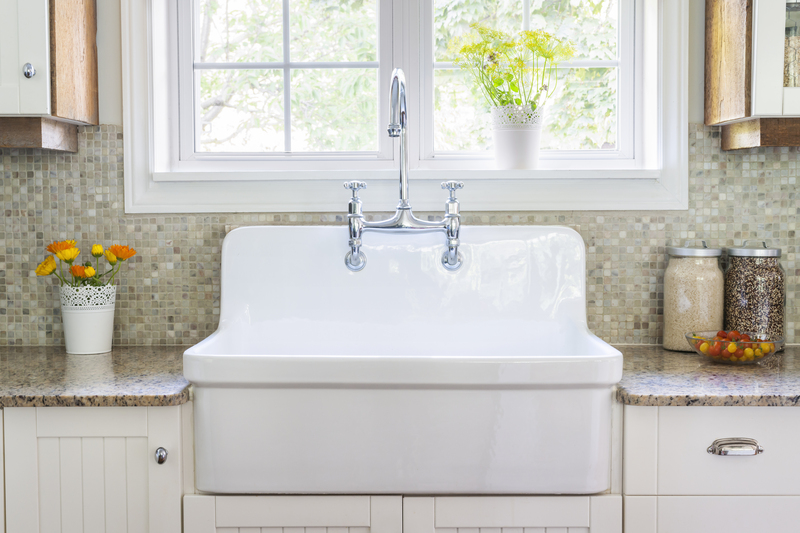Ultimate Guide to Cleaning uPVC Window Frames
Posted on 22/08/2025
Ultimate Guide to Cleaning uPVC Window Frames
uPVC window frames have become the go-to choice for homeowners and businesses alike due to their durability, modern appearance, and low maintenance. But just like any other aspect of your property, keeping them clean is essential to maintain their charm and longevity. In this comprehensive guide to cleaning uPVC window frames, you'll discover everything you need--from the best products to use, to step-by-step cleaning techniques, maintenance tips, and answers to commonly asked questions.
What are uPVC Window Frames?
uPVC, or unplasticised polyvinyl chloride, is an extremely popular material for window frames. Unlike traditional wood frames, uPVC frames are resistant to rot, weathering, and require far less upkeep. Yet, despite their resilience, uPVC window frames still need regular cleaning to avoid discoloration, stains, and the accumulation of dirt and debris.
Advantages of Choosing uPVC Window Frames
- Low maintenance: No painting or sealing required.
- Weather-resistant: Unaffected by harsh sunlight or rain.
- Long lifespan: Can last decades with proper care.
- Improved energy efficiency: Good insulation properties.
- Cost-effective: Affordable compared to wood or aluminium frames.

Why It's Important to Clean uPVC Window Frames
Sometimes, uPVC windows can appear dull or discoloured, especially if they are neglected. Over time, pollutants, grime, mold, and mildew can stick to the frames, detracting from their appearance and even causing long-term damage if not cleaned.
Benefits of Regularly Cleaning uPVC Window Frames
- Prevents discolouration and staining
- Helps maintain property value and appearance
- Reduces the risk of frame degradation
- Keeps windows operating smoothly
Preparations Before Cleaning uPVC Window Frames
Before you begin cleaning your uPVC window frames, some basic preparation can make the job easier and more effective.
Gather Your Cleaning Supplies
- Soft cloths or microfibre towels
- Bucket of warm water
- Mild dish soap or a gentle uPVC cleaner
- Non-abrasive sponge
- Soft-bristle brush or old toothbrush
- Spray bottle
- White vinegar (for stubborn marks)
- Baking soda (optional, for deeper cleaning)
- Window squeegee
- Protective gloves
Choose the Right Time and Conditions
- Pick a cloudy day: Direct sunlight may cause soap to dry too quickly, leaving streaks on your window frames.
- Ensure good ventilation: Especially if you're using any commercial cleaners.
Avoid These Mistakes
- Never use abrasive cleaners or rough pads, as these can scratch and damage the uPVC surface.
- Avoid highly acidic or solvent-based cleaners, which can degrade the frame material.
- Skip pressure washers, as high pressure can force water into seals and cause leaks.
Step-by-Step Guide: How to Clean uPVC Window Frames
Ready to restore your uPVC frames to their original shine? Follow these simple steps to get the best results:
1. Remove Loose Dirt and Dust
Start by using a dry soft brush or a vacuum cleaner with a brush attachment to loosen any dust, cobwebs, or debris from the window frame and sills. This prevents dirt from scratching the surface during cleaning.
2. Prepare Your Cleaning Solution
Fill a bucket with warm water and add a small amount of mild dish soap. Optionally, you can use a specialist uPVC cleaner available from most hardware stores.
3. Clean the Frames
- Dip a soft cloth or sponge into the soapy solution.
- Wipe down the uPVC frames, working from the top down. This prevents dirty water from dripping on areas you've already cleaned.
- For stubborn grime, use a soft-bristle brush or an old toothbrush to gently scrub into crevices and corners.
4. Address Stubborn Stains
For tough stains, make a paste with baking soda and water. Apply the paste to the stained area, let it sit for a few minutes, then gently scrub with a sponge. Alternatively, spray a mixture of white vinegar and water (1:1 ratio) onto stains, let it soak briefly, and wipe away.
5. Rinse Thoroughly
Rinse off the cleaned window frames with a clean, damp cloth and some fresh, warm water to remove any soap residue that might attract new dirt.
6. Dry and Polish
Use a dry microfibre towel or a soft lint-free cloth to gently dry and polish the uPVC frames. This prevents streaks and water marks, restoring their original shine.
How to Deal with Yellowed or Discoloured uPVC Window Frames
Over time, uPVC can become yellowed due to prolonged exposure to sunlight, pollution, or improper cleaning products.
Tips for Whitening Yellowed uPVC Frames
- Commercial uPVC Restorer: Available at most home improvement stores, these products can help restore whiteness.
- Baking Soda Paste: Apply a mixture of baking soda and water, let it sit for 5-10 minutes, then gently scrub and rinse.
- Vinegar Spray: Mix equal parts white vinegar and water in a spray bottle, apply to the frame, and wipe off after a few minutes.
- Avoid bleach: Bleach can actually cause further yellowing or damage to uPVC, so it's best avoided.
Recommended Products for Cleaning uPVC Window Frames
While homemade solutions are effective for regular cleaning, specialist uPVC cleaners or creams can tackle more persistent problems.
Popular uPVC Cleaning Products
- uPVC Cleaner Spray: Designed specifically for cleaning and restoring uPVC surfaces.
- uPVC Cream Cleaner: Removes ingrained dirt and polishes the surface. Use sparingly and always test in an inconspicuous area first.
- Multipurpose Non-Abrasive Cleaner: For everyday use, provided it is safe for plastics.
When using any specialist cleaner, always read the manufacturer instructions and test the product on a small area first.
Maintenance Tips to Keep Your uPVC Frames Looking New
Proper uPVC window maintenance will help your frames stay bright and attractive for years.
Routine Maintenance Checklist
- Clean window frames at least twice a year (or more often in urban/coastal regions).
- Wipe down seals and gaskets to prevent mold or mildew growth.
- Keep window tracks and drainage holes clear for smooth operation and to avoid water ingress.
- Lubricate window hinges and locks annually with a silicone-based lubricant.
- Check for signs of damage or perishing seals and replace as needed.
- Avoid taping or sticking items directly onto the uPVC frame, as adhesives can cause lasting stains.
How Often Should You Clean Your uPVC Windows?
For best results, sanitise and clean your uPVC frames at least every 3-6 months. In areas with high pollution, heavy traffic, or near the sea, consider a more regular schedule (monthly or bi-monthly) to prevent long-term buildup.
Common Mistakes to Avoid When Cleaning uPVC Window Frames
No ultimate guide to cleaning uPVC window frames would be complete without highlighting the most frequent pitfalls:
- Don't use abrasive scrubbing pads: These scratch the surface and create areas that trap dirt.
- Avoid solvent-based products such as nail polish remover or acetone: They can permanently mark or degrade the material.
- Don't use coloured cloths that could transfer dye onto the frame. Stick to white or neutral-coloured rags.
- Don't ignore window tracks and seals: Dirt build-up here can affect window function.
- Never try to paint or cover yellowing uPVC without specialist preparation and products.
Frequently Asked Questions about Cleaning uPVC Window Frames
Can I Use Bleach or Ammonia on uPVC Frames?
No. Both bleach and ammonia-based products are too harsh for uPVC and could cause fading, discoloration, or even degrade the material over time. Stick to mild soapy water or a cleaner intended for plastics.
How Do I Remove Mould or Mildew from My uPVC Frames?
- Mix one part white vinegar with four parts water and wipe down affected areas.
- For stubborn spots, a small amount of bicarbonate of soda (baking soda) gently scrubbed with a toothbrush can help.
- Ensure to dry the area well and keep window vents open to discourage regrowth.
How Can I Make My uPVC Windows Look Shiny Again?
After cleaning, buff the dry frame with a clean microfibre cloth. Specialist uPVC creams are available that can provide a gentle polish, restoring the original sheen. Avoid greasy products, as they can attract dust.
Is It Safe to Use a Jet Wash or Pressure Washer?
Using a pressure washer is not recommended on uPVC windows. The powerful jet can blast water into the seals, cause leaks, or even dislodge the window frames.
Professional Cleaning vs DIY: Which Is Best?
Most uPVC window frame cleaning is a straightforward, DIY-friendly task. However, professional services may be necessary if:
- The frames have significant staining or deep-seated mold/mildew.
- You have high or hard-to-reach windows.
- You want specialist restoration (whitening, scratch removal, or reglazing work).
For everyday maintenance and general cleaning, following this guide should deliver excellent results.

Key Takeaways--Ultimate Guide to Maintaining uPVC Window Frames
- Regular cleaning with mild soapy water is all you need for most dirt and debris.
- Avoid harsh chemicals, abrasives, or high-pressure water jets to protect the surface integrity.
- Address stains and discoloration promptly with baking soda paste or specialist uPVC cleaners.
- Routine maintenance prolongs lifespan and keeps windows operating smoothly.
With just a little care and attention a few times a year, your uPVC window frames will look fantastic, function effectively, and provide you with years of worry-free service. Remember, a clean window frame not only brightens your view but also enhances the overall impression of your home or business premises.
Conclusion
Cleaning uPVC window frames doesn't have to be a chore. Following the above methods, using the right materials, and avoiding common mistakes will help maintain the beauty and durability of your uPVC frames for decades. Invest a bit of time in upkeep, and your windows will continue to look as good as new. If you ever encounter stains or difficulties beyond your reach, don't hesitate to consult a professional for help.
Keep this guide handy for your seasonal cleaning routines, and enjoy sparkling, pristine uPVC window frames on your property every day!




